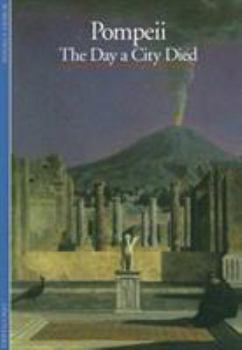Discoveries: Pompeii
Select Format
Select Condition 
Book Overview
In an illustrated survey of one of the most fascinating archeological discoveries in history, an expert on Pompeii uses photographs, maps, reconstructed city plans, mosaics, and drawings to provide a... This description may be from another edition of this product.
Format:Paperback
Language:English
ISBN:0810928558
ISBN13:9780810928558
Release Date:March 1992
Publisher:Harry N. Abrams
Length:215 Pages
Weight:0.10 lbs.
Dimensions:0.5" x 5.0" x 7.0"
Customer Reviews
3 ratings
Great starter for Pompeii enthusiasts
Published by Thriftbooks.com User , 19 years ago
After watching the Learning Channel's documentary, "Pompeii: The Last Day," I was pushed to know more about this beautiful city that suffered such a terrible death and that was way ahead of its time. My curiosity was satisfied, and then some, with this enlightening and informative book. I enjoyed the paintings of the scenes of what happened to people on that fateful day of 24th August 79 C.E., how the ash had frozen them in time and the next of how they were discovered in those same positions when they were undug nearly two thousand years later in 1961 (to give one example). For me, the best part was reading Pliny the Younger's letter to his friend Tacitus, written in 104 C. E., about the destruction Mount Vesuvius wrecked upon everyone that surrounded her and about how his uncle, Pliny the Elder, had died in Stabiae because of the noxious fumes that suffocated the air. You're not getting a better first-hand account than that! The intended audience for this book is not a scholarly one, so that would explain why it's not loaded with Latin and Greek words and/or phrases. But if the text contained such words, that's why Latin and Greek dictionaries are around - to look up those words. You'll need to look at this book a few times: One to read the text and another to just look at the pictures and read the equally informative captions. You'll learn alot. But no matter how much I've read and watched about the city over the years, I still can't grasp why Pompeii had to suffer so much. They were way ahead of time with the everyday instruments they used (a printing press, a duplicate of which would not be made until over a thousand years later), bathing to keep diseases at bay (something that Nostradamus would rediscover fifteen hundred years later during the Black Plague). As the author points out, Pompeii had a standard of living that would not be achieved again until the 1950's. (So much for progress!) A fantastic read.
Scrapbook about Pompeii
Published by Thriftbooks.com User , 23 years ago
This is the first book I read on Pompeii, and therefore my only source of knowledge about what happened there. The book was very easy to read, with almost no jargon or unnecessary details. On the negative side, the book does not follow a meaningful structure, and is almost like a scrapbook on Pompeii. There are plenty of colorful pictures, which have no mention in the text. So first you need to read the book, and then go through the pictures and read the notes on them. The book starts out describing the history of excavations in Pompeii. Then, we have chapters on the daily life in Pompeii, how they earned a living, the role of women in society, leisure in Pompeii, their relationship with Gods and their views on love and death. At the end there is a section called documents, which includes writings of various writers on Pompeii, including Mark Twain, Charles Dickens, and Stendhal. I don't feel like I learned everything there is to know about Pompeii. For example, I am not clear on whether escape was at all possible, or whether anyone survived. The information presented was interesting, but I feel there were gaps in the way it was presented. This is probably a good thing, because it stimulates one for further reading.
A Slick Pamphlet: All you Need to Learn about Pompeii
Published by Thriftbooks.com User , 24 years ago
Like all of the other books on Pompeii that I have reviewed at this web site, this one was also assigned for a class that I took on Pompeii at Tulane (Professor Spaeth, good teacher). I'd have to say that I loved this book the best, as I was always thumbing through it to take a closer look at the colorful pictures and neat passages quoting both ancient(in translation--thank god! ) and modern sources describing Pompeii. This book forms only a small part of the "Discovery" series, which is awesome and accessible monographs on every conceivable subject--from Alexander the Great to the Celtic World to Picasso.The book is also easy for children and adults alike to read. The book's primary goal is to entertain, but that does not certainly nullify the book's propensity to teach. A great triumph all around.Detailed maps of excavated regions and floorplans of principle edifices, lush illustrations reconstructing temples and houses, pictures of paintings and artifacts, plus detailed written descriptions of the ruins. Who could ask for more?There is also some bonus material, including short passages written by celebrities like Goethe and Mark Twain when they went to Pompeii and wrote about their experiences in their diaries, and some short biographies of the scholars in the 18th century who began to study Pompeii scientifically and not as some grandiose treasure hunt.Very fun stuff. Highly recommended. And the book doesn't write over anybody's head by using esoteric terms or include arcane and silly exerpts written in Greek and Latin with the tacit presumption that "Joe Blow" wouldn't understand the material because he only knows English. In the end we find that Pompeii, like everything on Earth, was comprised simply of ordinary people trying to make a living and achieve a little happiness. So why not learn the fun way?





